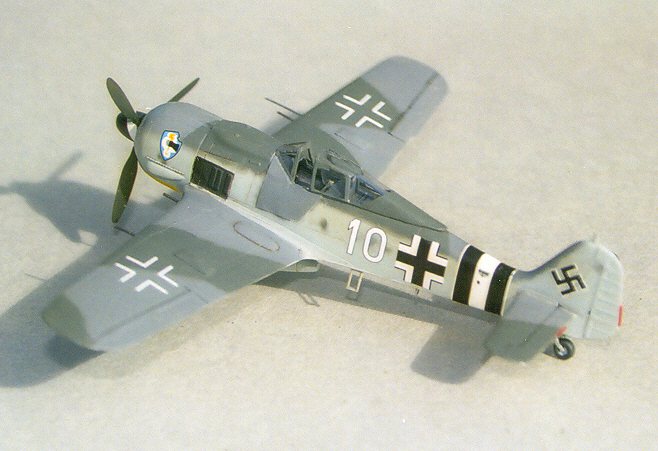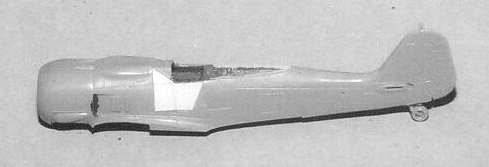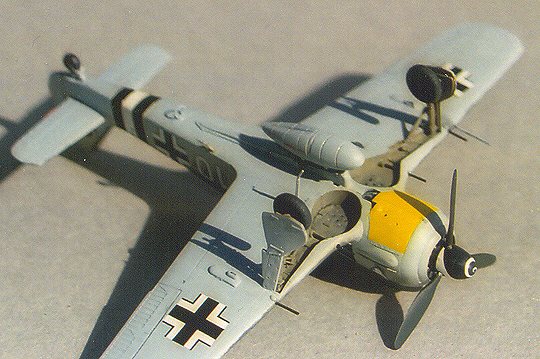
|
KIT: |
Revell AG 1/72 Fw-190A-8 |
|
KIT # |
4118 |
|
PRICE: |
£2.99 |
|
DECALS: |
One aircraft |
|
REVIEW & |
|
|
NOTES: |
Built as Sturmstaffel armored aircraft |

|
HISTORY |
Luftwaffe experience with B-17s and B-24s as early as late 1942 had led to the conclusion that rear attacks, while offering a better gunnery solution
by having a slower closing speed, exposed the attacking fighter to too much defensive firepower. It was in response to this that the head on attacks
were developed. A pilot only had 3-5 seconds while in range to fire due to
the high closing speeds of the head on attack, but it also meant the bomber gunners had much less time to shoot back too.
Sturmstaffel 1 was formed in late 1943 as another means of dealing with the heavily armed and escorted
8AF bombers. This unit was formed under the command of Major Hans-Günter von Kornatzki in October 1943 and was equipped with heavily armed and armored Fw-190A aircraft. The unit's first mission came in January 1944, and by May
1944 it had been disbanded with the surviving pilots being assigned as the nuclei
of Sturmgruppe that were formed in several of the Jagdgeschwaderen.
Sturmstaffel tactics were different. The entire staffel would attack as a
group, line abreast, sweeping into a bomber formation and bringing the massed firepower of an entire staffel to bear. They would also attack from
the rear, giving themselves more time to shoot. A massed sturmstaffel attack could (and did) knock five or six bombers out on one pass. An entire heavy
bomber squadron could be decimated in one of these attacks.
The aircraft were Fw 190A-6 and A-7s. Armament was usually 4 MG 151/20 cannon. The upper nose machine guns were normally removed to make up for
some of the weight of the additional armor - armored windscreen (50mm), armored side glass (30mm) panels, and armor plate (5mm) around the cockpit
sides. This additional armor did provide some extra protection for the pilot but it was still extremely hazardous duty. One book lists 37 pilots
serving in the sturmstaffel, seven survived the war, the fate of the 8th pilot is unknown so at least 29 out of 37 pilots were killed, missing or
died of wounds - not good odds!
|
THE KIT |

The kit used was the Revell-Germany kit of the Fw-190A-8, (#4118) built as an A-7. This particular kit was issued as a night fighter with wing mounted FuG218 radar or with underwing gun pods each holding two MG 151/20 cannon. The basic kit has also been boxed as a glide bomb carrier as well as an aerial torpedo carrier (both experimental types). I prefer the Revell kit to Hasegawa’s 190 series.
The Revell kit has an acceptable interior and the wheel wells are closer the correct depth then Hasegawa’s. I removed the canopy frame, the only criticism of the kit is that the canopy is molded shut and the frame is part of the fuselage, in anticipation of using a vac replacement. As far as shape and dimensions are concerned, it matches the A. Bentley drawing from Scale Models International and looks like a Fw-190
|
CONSTRUCTION |
The kit was assembled straight from the box except for these changes or additions:
Armor glass was added to the vac replacement canopy by cutting panels from .015 clear plastic stock, so the scale thickness is about right. The panels were attached by painting a heavy coat of Future Floor Wax onto the clear portion of the canopy and letting the Future ‘glue’ the panel on. This way there is no nasty side effect from any type of glue on the clear parts. Once the Future dries, the entire canopy was dipped into Future again, sealing on the panels. They will now stay attached under normal conditions unless you pry them off (which can be done with no damage to any of the parts!).
 The fuselage armor was made from .005 plastic
stock and attached with the thin version of CA. The kit windscreen was used as
its thickness represents the 50mm armored glass better then the vac
windscreen.
The fuselage armor was made from .005 plastic
stock and attached with the thin version of CA. The kit windscreen was used as
its thickness represents the 50mm armored glass better then the vac
windscreen.
Outboard cannon were added (an option in the kit). I made an error here because I added both the upper and lower cannon bulges and the upper wing cannon bulges were only used if Mk108 30mm cannon were added, not the MG 151/20 cannon.. As mentioned above, the canopy framing was removed from the kit. The molded on cannon in the wheel well were removed and holes were drilled through the landing gear bays to take plastic tubing to represent the inboard cannon and blast tubes. Strictly speaking, this puts the cannon too deep into the wheel well as it is molded, but I like the effect better then the molded on, half relief cannon that all Fw-190 kits provide.
|
PAINT & DECALS |

The kit was painted using PollyScale acrylics. Mid war Luftwaffe grays 75/74 were used on the upper surfaces, with 76 on the underside. Mottling was done with a combination of 74/75/76. The underside of the cowl had a yellow ID panel. Markings and color notes came from EagleCal sheet 7207, which covers the Sturmstaffel. This sheet was also issued as 4807. A companion sheet was also issued for IV(sturm)/JG3. The particular aircraft I modeled, ‘weiße 10’ came from reference 1 and was pieced together from numbers on the EagleCal sheet. This aircraft was flown by Lt Seigfried Müller 8 April 1944 when he claimed his third abschuss (victory); a B-24. The aircraft itself was damaged in a crash landing upon his return to base. All canopy framing was done with suitably painted decal strips.
|
CONCLUSIONS |
With a little extra work, a very different Fw 190A can be added to the collection.
|
REFERENCES |
Mombeek, Eric. Sturmstaffel the War Diary. Classic Publications, 2000.
Mombeek, Eric. Sturmjäger, zur geschicte des Jagdgeschwaders 4 und der Sturmstaffel 1, Bands 1.&2 La Porte d’Hoves 1997,1999. (German text)
General Fw-190 references:
Aero Detail #6, Fw 190A/F
Rodeike, Peter Focke Wulf Jagdflugzeug Fw-190A, Fw-190D ‘Dora’, Ta-152H. struve-druck, 1998. (German text)
If you would like your product reviewed fairly and quickly by a site that has over 900 visits a day, please contact me or see other details in the Note to Contributors.